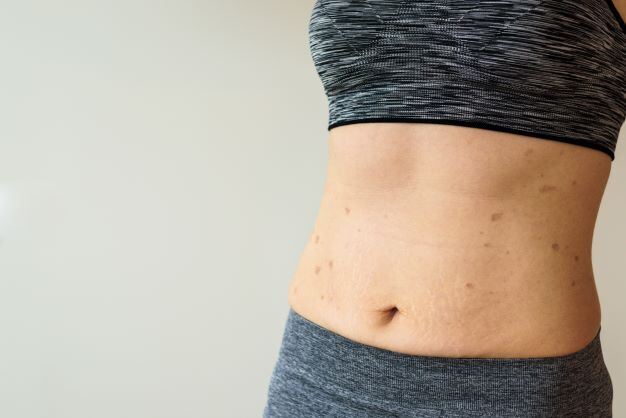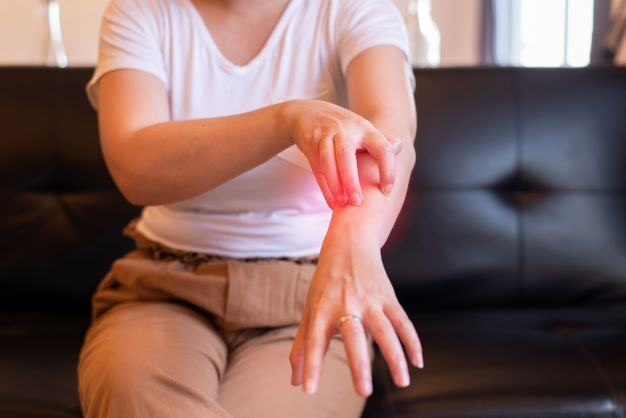
Psoriasis and Natural Treatment: Ozone Therapy
Did you know that psoriasis affects 125 million people globally, or around 2% to 3% of the total population? Furthermore, the World Health Organization estimates that this condition affects roughly 2,2% of people in the United States.
Some cultures are more affected than others. Northern Europe has the highest prevalence of psoriasis, whereas eastern Asia has the lowest prevalence.
What is psoriasis?
Psoriasis is an autoimmune disease that causes the fast accumulation of skin cells. Scaling is caused by a buildup of cells on the surface of your skin. Around them, inflammation and redness are pretty common. Psoriatic scales are often whitish-silver in color and appear in dense, red areas. These patches can sometimes shatter and bleed.
Psoriasis is caused by an accelerated skin-production process. Skin cells usually develop deep within the skin and slowly climb to the surface. They eventually fall off. A month is the average life cycle of a skin cell. In psoriasis, they do this in just three to four days. Instead of shedding, skin cells pile up on the skin’s surface.
Scales commonly form on joints such as the elbows and knees. They can, however, appear anywhere on your body, including:
- Neck
- Feet
- Hands
- Face
- Scalp
- Mouth
- Nails
- Area around the genitals.

What causes psoriasis?
Its development is heavily influenced by the immune system and genetics. The precise cause of psoriasis remains unknown. Something, according to researchers, triggers your immune system, but it’s most likely the result of a mix of risk factors. However, we do know that psoriasis isn’t contagious. It cannot be passed from one person to another.
Triggers vary from person to person, however the following are some of the most common:
- Your genes and your immune system
- Alcohol consumption
- Smoking
- Hormone changes (menopause, pregnancy)
- Emotional stress
- Medications (blood pressure medications, anti-malarial drugs, lithium and other mood stabilizers, antibiotics, and NSAIDs)
- Skin injuries (cuts, scrapes, bug bites, infections, or surgeries)
- Strep infections
- Weather (sunburns, dry air, cold temperatures)
- Weight (obesity)
Also, psoriasis is frequently related to a variety of other conditions, such as:
- Anxiety
- Depression
- Heart disease
- Inflammatory bowel disease
- Type II diabetes
- Psoriatic arthritis (along with arthritic symptoms, patients also have joint inflammation).
What are the symptoms of psoriasis?
Symptoms usually appear between the ages of 15 and 25, however they can start at any age. Psoriasis can affect men, women, and children of various skin tones.
The following are the most common symptoms of psoriasis:
- Irritated patches of skin that look red on light skin and brown or purple on dark skin
- Pain around them
- Red areas having whitish-silver scales, whereas purple and brown patches having gray scales
- Sore, swollen joints
- Itching and burning sensations
- Dry skin that may break and bleed
- Thick, pitted nails.
The majority of people with psoriasis have “cycles” of symptoms. For a few days or weeks, the condition may cause severe symptoms, which eventually go away and become nearly unnoticed. The problem may flare up again in a few weeks or if made worse by a frequent psoriasis trigger. These symptoms might even go away for good.
Types of psoriasis
1. Plaque psoriasis
The most prevalent type of psoriasis is plaque psoriasis. According to the American Academy of Dermatology (AAD), plaque psoriasis affects 80 to 90% of patients with the disease. It forms red, inflammatory patches on light skin tones and purple, grayish, or deeper brown areas on darker skin tones, making it more difficult to diagnose in persons of color. Elbows, knees, and the scalp are frequent places for these plaques.
2. Guttate psoriasis
This type usually affects children, causing small pink, or violet patches. The chest, arms, and legs are the most prevalent areas for guttate psoriasis. Unlike plaque psoriasis, these areas are rarely thick or swollen.
3. Pustular psoriasis
Adults are more likely to develop pustular psoriasis. It creates white, pus-filled blisters and inflamed skin that is red or violet in color, depending on the skin tone. On darker skin tones, it might appear as a more vivid violet tint. Pustular psoriasis usually affects smaller sections of the body, such as the hands or feet, although it can also affect other parts of the body.
4. Inverse psoriasis
Bright red, shiny, inflamed skin is a symptom of inverse psoriasis. It appears as patches beneath the armpits or breasts, in the groin, or around skinfolds in the genitals.
5. Erythrodermic psoriasis
According to the National Psoriasis Foundation, erythrodermic psoriasis is a severe and extremely rare form of psoriasis. This shape frequently covers extensive areas, in big sheets or pieces. The skin seems to be sunburned. With this type of psoriasis, you may get a fever or become severely ill.
Because this sort of infection may be fatal, you must schedule an appointment with a qualified doctor as soon as possible.
Diagnosis
1. Physical exam
This is pretty straightforward to diagnose for a specialist, especially if you have plaques on areas such as:
- Nails
- Elbows
- Ears
- Scalp
- Knees
- Belly button.
Your doctor will give you a full physical exam and ask if people in your family have psoriasis.
2. Lab tests
The doctor may do a biopsy, which involves removing a tiny piece of skin and testing it to see if you have a skin infection. There’s no other test to confirm or rule out psoriasis.
Treatment
Fortunately, there are several therapies available. Some reduce irritation and dry skin by slowing the formation of new skin cells. Based on the extent of your rash, where it is on your body, your age, your general health, and other factors, your doctor will create a treatment plan that is appropriate for you. The ones that are often used include:
- Moisturizers for dry skin
- Steroid and retinoid creams
- Coal tar (used especially for scalp psoriasis available in shampoos, lotions, creams, and bath solutions)
- Vitamin D therapy
These are some of the treatments used for moderate to severe psoriasis:
- Light therapy
- Methotrexate
- Retinoids
- Cyclosporine
- Biologic treatments.
Natural treatment – Ozone therapy
Because of its powerful oxidizing properties, ozone was first used in clinical settings as a sterilizing agent. More than 50 different pathological illnesses have been treated with it, including infectious skin diseases, allergic diseases, erythema scaly diseases, wound healing, and ulcer recovery.
Ozone treatment involves injecting ozone gas into sick or damaged regions to improve oxygen supply. It has the ability to trigger and activate the body’s antioxidant enzyme system. Disease-causing microorganisms cannot survive in high-oxygen settings, therefore this type of complementary therapy successfully kills harmful bacteria by exposing them to high oxygen levels.
Ozone treatment has been proven to enhance the skin’s condition in those with psoriasis. It neutralizes the toxins in the blood, decreases inflammation and edema, as well as softens the skin. Higher oxygen levels improve overall health by boosting your immune system and enhancing your ability to combat stress.
A total of 10 psoriatic patients diagnosed with psoriasis were enrolled in a study conducted by Jinrong Zeng and Li Lei. The therapeutic efficacy of a short-term ozone therapy for psoriatic patients was examined by a group of experts. They discovered that blocking the NF-B pathway with ozone treatment reduced inflammatory responses in psoriasis. The findings revealed that ozone therapy is a safe and effective treatment for psoriasis that deserves further clinical research and use.
Another research looked at 118 people between the ages of 18 and 66 who had advanced stages of severe psoriasis. The inclusion of ozone therapy in the complex treatment of psoriasis led to more rapid and complete positive skin process dynamics, decreased seromucoid and C-reactive protein levels, adjusted impaired coagulogram indices, and normalized the lipid peroxidation process level. The procedures were well tolerated by the patients.
Under the supervision of Dr. Adriana Feher, you may receive excellent treatment at Ozone Therapy and Vitamins Centre Luxembourg. After a thorough examination and based on your psoriatic condition, the doctor will apply one of the following ozone treatments:
- Systemic therapy
- Local therapy
- Transdermal therapy.
Prognosis
Psoriasis has no cure, however ozone treatment has been shown to significantly improve symptoms, even in severe cases. Recent research suggests that if you better control psoriasis inflammation, your risk of heart disease, stroke, metabolic syndrome, and other inflammatory diseases diminishes. Send an email to [email protected] or phone +352 2600 8907 to make an appointment at our clinic.

